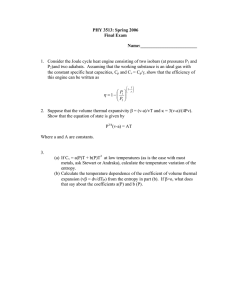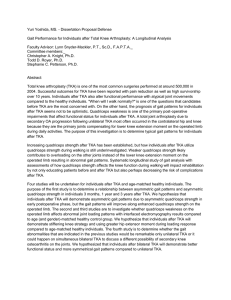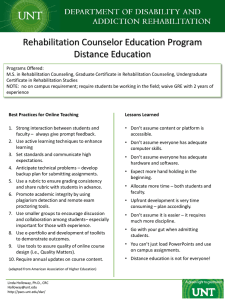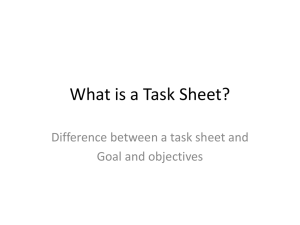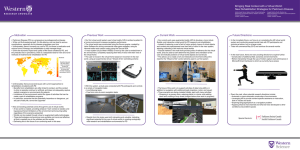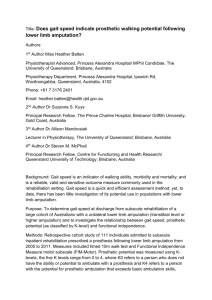Remote Monitoring of Rehabilitation After Total Knee Replacement
advertisement
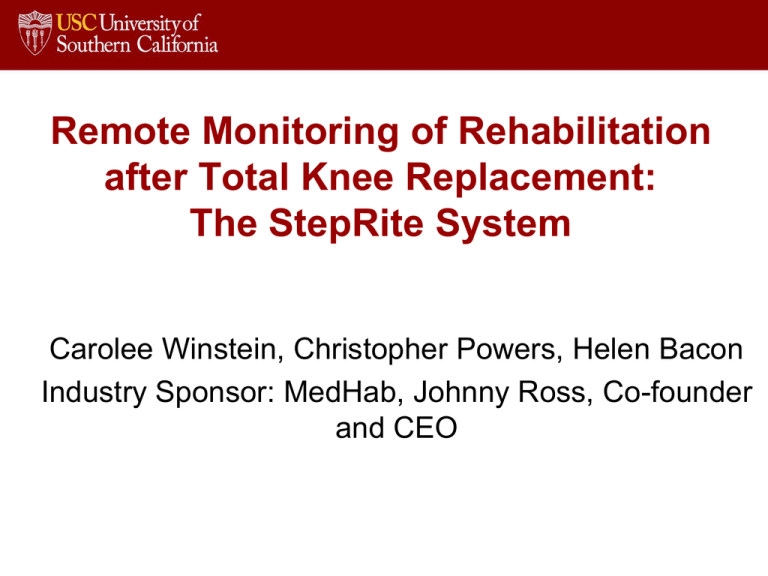
Remote Monitoring of Rehabilitation after Total Knee Replacement: The StepRite System Carolee Winstein, Christopher Powers, Helen Bacon Industry Sponsor: MedHab, Johnny Ross, Co-founder and CEO A few facts, definitions, and the future: • Exponential advances across myriad technological fields are conspiring to usher in an era of profound change • Never underestimate an exponential. --Carl Sagan Background and Motivation • More than 400,000 TKAs are performed per year. More are expected with aging baby boomers reaching 65 yr of age. • The operation typically involves substantial postoperative pain, and includes vigorous physical rehabilitation. • Healthcare dollars allotted to rehabilitation declining. 6 Need to develop remote monitoring of rehabilitation after TKA • To enable better adherence with exercise protocols • Optimize self-management of recovery • Variation in patient’s independent exercise and activity after TKA surgery may contribute to variable functional gains (Franklin et al., 2006) 7 StepRite System • Developed by MedHab (http://www.medhab.com/) • Allows the physical therapist to monitor physical activity and exercise remotely • StepRite provides a pressure sensing dashboard for the physical therapist and physician. • It provides 3D tracking, pressure sensing, real-time wireless communication and a HIPAA secured user interface website. 8 StepRite System • Provides quantitative feedback about exercise compliance comparing the surgical side with the non-surgical side • Real time feedback during exercise and weight-bearing activities • It is a developing remote, interactive monitoring system 9 Johnny Ross Jr. CEO MedHab LLC PETRA ‘14 Development of a Smart Insole Tracking System for Physical Therapy and Athletics Motivation for the Industry Partner • Johnny Ross - Knee surgery in 2008 • Poor results with traditional rehab methods • Enhance rehabilitation with quantitative data Design Goals • Wireless, remote monitoring, force sensing device • Monitor patient rehabilitation • Enhance athletic training Insole Hardware • Force sensors • 9-axis sensor (gyroscope) Pressure Sensor insole (earlier version) Based on pressure sensing and accelerometry technology 14 Algorithm Development • Custom algorithms needed – Translate raw sensor data into various information • Gait Analysis • Range-of-Motion analysis • Power Meter Quality Assurance • Hardware challenges – Calibration – Validation System Architecture • Two versions – Medical & Athletic Mobile Applications • StepRite (Medical) – Simple interface – Collect data from insoles – Sends data to web service • Log in screen shot • Medical version: Web-based Clinician Interface – enter protocol, review recorded patient data, adjust Protocol page with showing • Protocol page showing icons of protocol standing pressure from which to choose Patient Interface – review progress • Gait screen shot • Cycling screen shot • Range of motion here • Pressure here • Provider compliance dashboard • Patient compliance dashboard • Provider and Patient Compliance Reports Stage of Research • Intervention development • Intervention efficacy 25 Project Objective: • We will test the hypothesis that patients who use the device post-surgery will demonstrate superior short-term improvements (i.e., 6 months post TKA)—two outcome measures: – Self-reported functional outcomes (WOMAC) – Gait parameters (GaitRite system) • Compared to a control group who does not use the device (standard care with log book). 26 Specific Aims: • To compare the short-term changes in gait parameters after TKA between those who use the StepRite device and those who follow a standard therapy program with out the device. • To compare the short-term self-reported functional outcomes after TKA between those who use the StepRite device and those who follow a standard therapy program without the device. 27 Work in progress • Exercise protocol will be programmed into the device. • IRB and development of industry partner contract. • Development of protocol including the number of HH (home health) and OP (out-patient) visits (in-person and remote) for each group. • N= 25/group for the efficacy study • Proposed time line (~1-1.5 yr project) )28 Acknowledgements • Deaton Engineering • TECH Fort Worth Technical Incubator • Angelo State, Lamar Universities, & Texas A&M, Corpus Christi • Texas Manufacturers Assistance Center Questions
